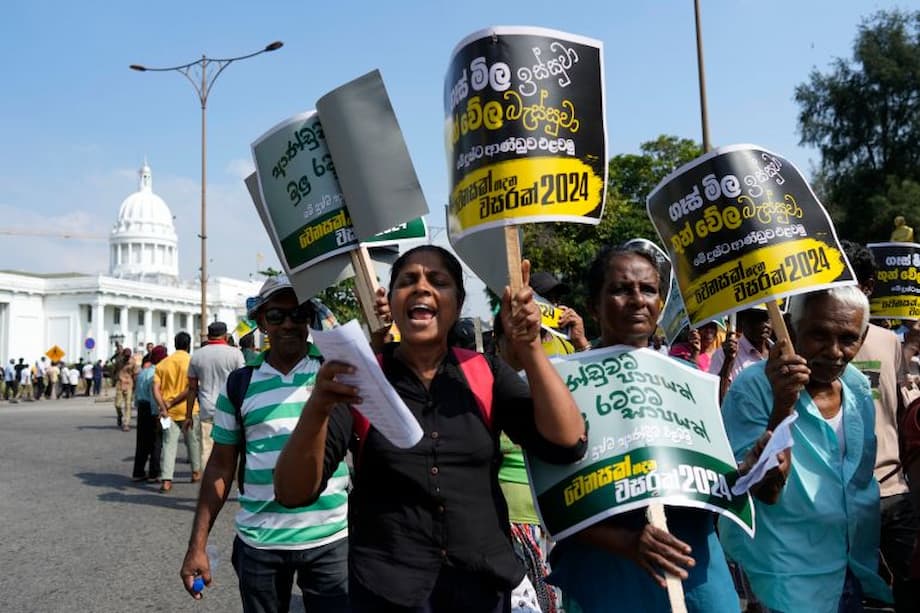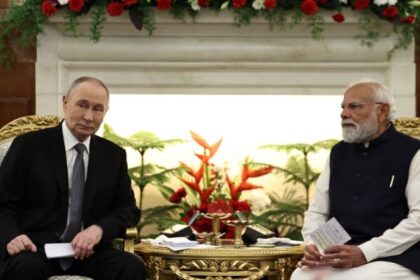Sri Lanka Approves Controversial Debt Deal Amid IMF Pressure, Sparking Austerity and Global South Debate
The new government in Colombo endorses a $14.7 billion debt restructuring, highlighting the human cost of IMF-led austerity and the broader crisis facing developing nations.
On September 19, 2024, Sri Lanka’s new government, led by President Anura Kumara Dissanayake, endorsed a controversial $14.7 billion foreign debt restructuring agreement, originally negotiated by its predecessor. The deal, a key demand from the International Monetary Fund (IMF), comes as Sri Lanka continues to recover from its 2022 economic collapse, which triggered mass protests, a presidential resignation, and a historic shift in political power. While the IMF and international creditors have praised the agreement as a step toward stability, critics warn that the resulting austerity measures are deepening hardship for millions of Sri Lankans and echoing a wider debt emergency across the Global South.
- Sri Lanka Approves Controversial Debt Deal Amid IMF Pressure, Sparking Austerity and Global South Debate
- How Did Sri Lanka’s Debt Crisis Unfold?
- What Does the Debt Restructuring Deal Involve?
- How Has the IMF Shaped Sri Lanka’s Recovery?
- Why Is Sri Lanka’s Crisis Part of a Global Pattern?
- What Are the Political and Social Consequences?
- Are There Alternatives to the Current System?
- What Lies Ahead for Sri Lanka and the Global South?
- Key Points
How Did Sri Lanka’s Debt Crisis Unfold?
Sri Lanka’s economic crisis erupted in 2022 after years of unsustainable borrowing, poor fiscal management, and a series of external shocks. The country defaulted on its foreign debt for the first time in its history, running out of foreign exchange to pay for essential imports like food and fuel. The crisis was compounded by the Covid-19 pandemic, the 2019 Easter bombings, and the global fallout from the Russia-Ukraine war, all of which battered tourism and export revenues.
Public anger boiled over in the Aragalaya movement, a broad-based citizens’ protest demanding accountability and an end to political corruption. The movement forced the resignation of President Gotabaya Rajapaksa. However, the subsequent administration under Ranil Wickremesinghe delayed new elections and instead negotiated a $3 billion IMF bailout, Sri Lanka’s 17th such program, in exchange for sweeping economic reforms and austerity.
By September 2024, voters delivered a landslide victory to the left-leaning National People’s Power (NPP) coalition, led by Anura Kumara Dissanayake, on promises of economic justice and a break from the past. Yet, the new government quickly found itself constrained by the IMF agreement and the terms set by international creditors.
What Does the Debt Restructuring Deal Involve?
The restructuring covers $14.7 billion in foreign commercial credit, including $12.5 billion in international sovereign bonds and $2.2 billion owed to the China Development Bank. Under the deal, private creditors agreed to a 27 percent reduction (“haircut”) on their loans and an additional 11 percent cut on interest owed. The agreement also includes “Macro-Linked Bonds,” which increase payments to creditors if Sri Lanka’s economy grows faster than IMF projections—effectively penalizing economic recovery.
Despite initial calls for better terms, President Dissanayake’s government decided to honor the agreement after talks with an IMF delegation in Colombo. The finance ministry confirmed its endorsement, though the deal still requires parliamentary ratification. The government dissolved the assembly and called snap elections for November 14, 2024, with the new legislature set to convene a week later.
Interest payments will consume 41 percent of government spending in 2025, making Sri Lanka one of the world’s most indebted countries relative to GDP. Even after restructuring, the public debt-to-GDP ratio is projected to remain around 95 percent by 2032.
How Has the IMF Shaped Sri Lanka’s Recovery?
The IMF’s Extended Fund Facility (EFF) program for Sri Lanka demands a primary budget surplus of 2.3 percent by 2025, requiring the government to raise taxes, cut spending, and privatize state-owned enterprises. Key reforms include:
- Privatizing state-owned enterprises and utilities
- Freezing public sector hiring
- Delaying or canceling rural infrastructure projects
- Reducing subsidies for fuel, agriculture, and fishing
- Increasing energy prices and removing price controls
- Disconnecting the Central Bank from state control
These measures are intended to restore macroeconomic stability and reassure creditors. However, they have also led to a sharp contraction in public investment, stagnating health and education budgets, and a heavy burden on working people’s retirement savings, especially the Employees Provident Fund (EPF).
President Dissanayake’s first budget speech in February 2025 acknowledged the constraints, admitting that Sri Lanka lacks economic independence and remains under IMF monitoring. The government pledged to raise public investment from 13 to 18 percent of expenditure, but economists warn that if IMF revenue targets are enforced, investment will likely be cut first.
Who Is Paying the Price?
The human cost of Sri Lanka’s “recovery” is stark. Civil society groups estimate that 6.3 million people are now skipping meals, and at least 65,600 face severe food shortages. Inflation and higher taxes have eroded real incomes, while fuel and input costs have soared for fishermen and farmers. Public health spending for 2025 is just 1.5 percent of GDP—five times less than the amount allocated to service public debt.
Fishermen report that fuel costs remain steep, eating into their incomes, while farmers struggle with rising input prices, climate shocks, and reduced state support. The government has reinstated some subsidies for agriculture and fishing, but many say it is not enough to offset the impact of austerity.
Public sector workers face a hiring freeze, and major infrastructure projects in transport and irrigation have been delayed or canceled. Funding for health and education has stagnated even as costs rise, and pension reforms have reduced retirement security for millions.
Women and marginalized communities are disproportionately affected. Austerity measures have led to job losses in sectors where women are overrepresented, increased unpaid care work, and heightened economic insecurity. The IMF’s policies, critics argue, have deepened inequality and poverty, undermining the very foundations of social stability.
Why Is Sri Lanka’s Crisis Part of a Global Pattern?
Sri Lanka’s predicament is not unique. Across the Global South, countries are grappling with a mounting debt crisis that threatens development and sovereignty. According to the United Nations Conference on Trade and Development (UNCTAD), half the world’s population—about 3.3 billion people—now live in countries that spend more on interest payments than on health or education. In 2024 alone, developing countries paid $921 billion in interest, with African nations among the hardest hit.
Debt payments in developing countries now exceed national revenues in many cases, with 118 nations facing debt distress and 31 either defaulting or losing access to external financing. The World Bank reports that interest payments for low-income nations have quadrupled over the past decade. Private creditors, such as banks, investment funds, and pension funds, now own almost half of developing nations’ external public debt, and they are often reluctant to participate in debt reduction or restructuring.
Existing debt relief mechanisms are widely seen as inadequate—ad hoc, fragmented, and tilted in favor of creditors. The G20’s Common Framework for Debt Treatments has stalled, and the IMF’s own programs often prioritize creditor interests over those of borrowing countries.
How Did the Global South Get Here?
The roots of the crisis stretch back decades. After decolonization, many developing countries turned to the World Bank and IMF for loans, often in exchange for policies that cut social spending, privatized state assets, and opened economies to global markets. These “structural adjustment” programs, first imposed in the 1980s, were intended to reduce debt but instead entrenched cycles of dependency, austerity, and underdevelopment.
Since 1980, the external debt of developing countries has doubled every ten years, multiplying by 19 between 1980 and 2023. Governments and private players in the Global South (excluding China) paid over $971 billion to foreign creditors in 2023 alone. In many cases, debt service now exceeds spending on education or health.
Private creditors have become increasingly dominant, and their refusal to participate in meaningful debt relief has made restructuring slow and painful. For example, Zambia’s 2020 default took four years to resolve, with private creditors negotiating better terms for themselves than public lenders.
Recent global shocks—rising US and EU interest rates, the Covid-19 pandemic, and the Ukraine war—have further strained developing economies. As private financing dried up, multilateral lenders like the IMF and World Bank stepped in with emergency loans, but these came with strict conditions: more austerity, privatization, and economic liberalization.
What Are the Political and Social Consequences?
The IMF’s intervention in Sri Lanka is part of a broader pattern where international financial institutions and private creditors wield significant influence over national policymaking. Critics argue that this undermines democracy and sovereignty, forcing governments to prioritize debt repayment over social needs.
Ahilan Kadirgamar, a Sri Lankan political economist, explains:
The IMF’s program for Sri Lanka demands a high primary budget surplus, leading to increased taxes and austerity, and prioritizes debt repayment over social spending. This has resulted in severe economic contraction, with high food costs, reduced access to essentials, and cuts to public services.
Many in Sri Lanka and beyond see the crisis as a human rights issue. A recent UN Human Rights Council roundtable concluded that the debt crisis is fundamentally a human rights crisis, calling for reforms to the international financial architecture to protect the rights to food, health, and education.
Grassroots movements are responding. In September 2025, more than 500 delegates from around the world will gather in Kandy, Sri Lanka, for the 3rd Nyeleni Global Forum for food sovereignty. The forum will bring together small-scale food producers, Indigenous peoples, trade unions, and researchers to strategize alternatives to the current debt-driven model. Key themes will include debt cancellation, climate reparations, and the democratization of debt governance.
Are There Alternatives to the Current System?
Many experts and activists argue that the current approach to debt and development is unsustainable. They call for a permanent, transparent debt resolution mechanism centered on justice, development, and national sovereignty. Proposals include:
- Unconditional debt cancellation for countries in distress
- Reparations for historical injustices and climate damage
- Reforms to the global financial system, including a UN Framework Convention on Sovereign Debt
- Responsible lending principles and automatic debt payment suspensions during shocks
- New Special Drawing Rights (SDRs) and rechanneling unused SDRs through multilateral development banks
- Debt-for-climate swaps, as seen in Barbados, to link debt relief with green investments
The IMF’s Resilience and Sustainability Trust (RST), launched in 2022, aims to provide concessional, long-term financing to help countries address structural challenges like climate change. Early experiences in Barbados and Jamaica suggest that linking debt relief to climate action can create fiscal space for sustainable development. However, critics argue that the amounts involved are still too small and that broader reforms are needed.
Borrowing countries are beginning to coordinate more effectively, forming groups like the Common Leveraging Union of Borrowers to strengthen their negotiating positions. Feminist perspectives are also gaining visibility, highlighting the gendered impacts of debt and austerity.
What Lies Ahead for Sri Lanka and the Global South?
Sri Lanka’s experience offers valuable lessons for other middle-income countries facing post-pandemic debt distress. While the economy is showing signs of stabilization—positive growth, low inflation, a tourism boom, and a strong stock market—significant challenges remain. The outflow of skilled professionals, with over 300,000 migrating in 2024 alone, threatens long-term development.
The new government must chart a path toward inclusive and transformative growth that ensures debt sustainability and avoids future crises. This includes focusing on high-growth sectors like manufacturing, ICT, and sustainable tourism, as well as strengthening economic ties with regional partners. Fiscal sustainability is critical, and the government may need to restructure or privatize loss-making state-owned enterprises.
Implementation will be a challenge, given weak state capacity and an inexperienced parliament. Building expertise in governance and improving public sector delivery will be essential. International support, both financial and technical, will play a key role.
For the Global South as a whole, the crisis has reignited calls for a new international financial architecture that prioritizes people’s dignity over creditor profit. As the world prepares for the Fourth International Conference on Financing for Development (FfD4) in Spain, the pressure is mounting for bold action to overhaul the debt system and create space for sustainable, equitable growth.
Key Points
- Sri Lanka’s new government approved a $14.7 billion debt restructuring deal, honoring an agreement made by its predecessor under IMF pressure.
- The IMF program requires austerity measures, including higher taxes, spending cuts, and privatization, leading to widespread hardship for ordinary Sri Lankans.
- Interest payments will consume 41 percent of government spending in 2025, with public debt projected to remain high for years.
- Sri Lanka’s crisis is part of a broader debt emergency affecting the Global South, where many countries spend more on debt service than on health or education.
- Critics argue that IMF-led reforms undermine sovereignty, deepen inequality, and prioritize creditor interests over social needs.
- Grassroots movements and experts are calling for debt cancellation, climate reparations, and a reformed global financial system.
- The upcoming Nyeleni Global Forum in Sri Lanka will focus on building alternatives to the current debt-driven model.
- Long-term recovery depends on inclusive growth, investment in high-potential sectors, and international cooperation for fairer debt solutions.












